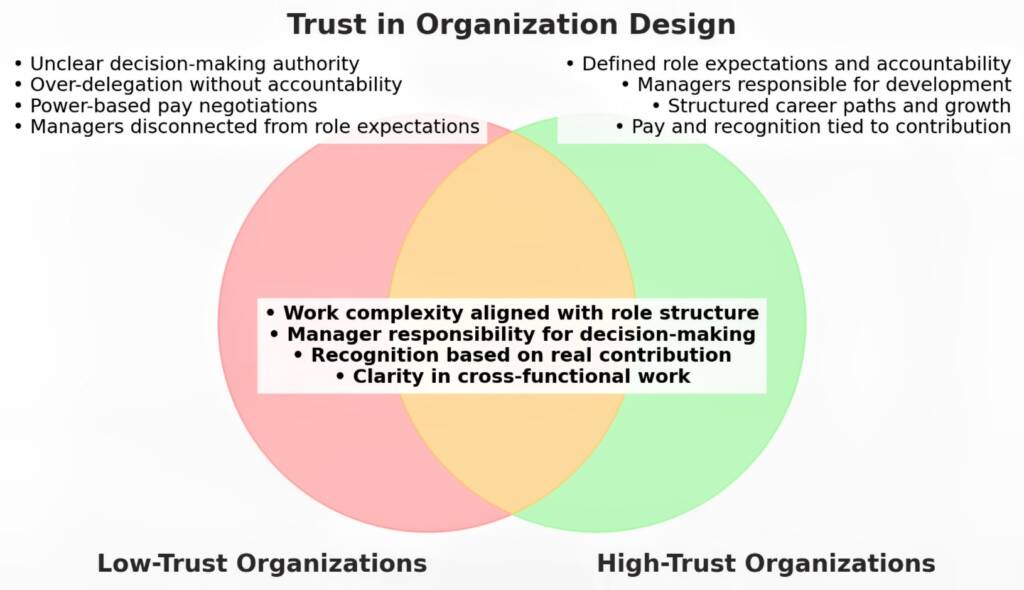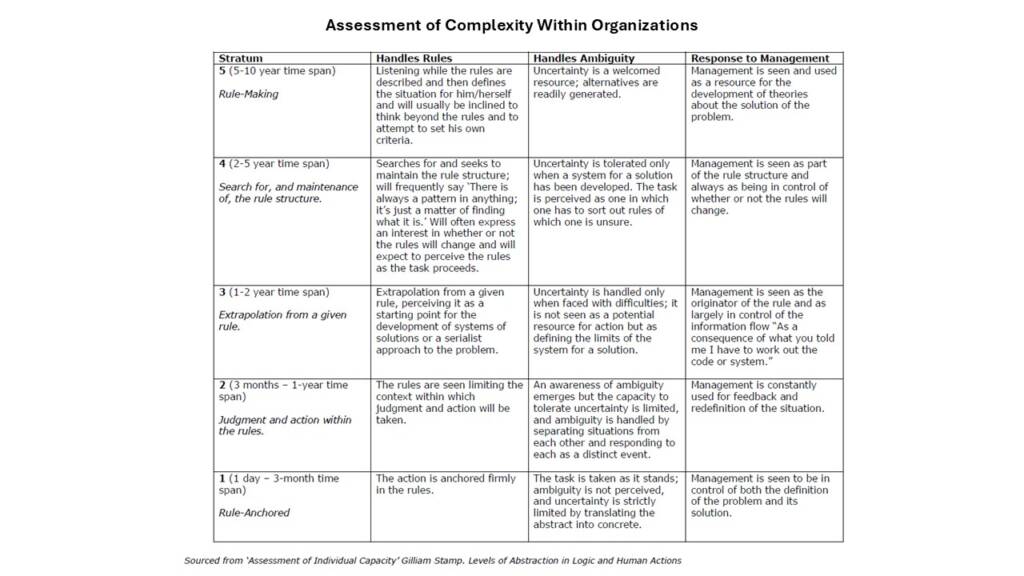Organizations either attract or repel trust based on how they structure work, define accountability, and manage relationships. Trust isn’t an engagement score or a leadership philosophy; it is the byproduct of good organizational design.
What Is Trust in Organizations?
Within organizations, trust is predictability in action. People trust systems that are clear, fair, and functional. They distrust systems that are ambiguous, inconsistent, or unpredictable in ways that undermine their ability to succeed. However, trust does not require that organizations be simple. Organizations are inherently complex. Complexity is not inherently trust-repelling; when it is structured well, it reinforces trust by enabling people to process and respond to challenges at the right level of responsibility.

_________________________
Trust-Attracting Example:
Sarah, a customer service representative, logs in knowing her role expectations; she handles inquiries, has clear guidelines for resolving issues, and knows when to escalate a problem. If she needs support, her manager is available, and decisions follow a structured process. When she solves a difficult case, she receives recognition in a fair and consistent way. Sarah feels confident in her work and focuses on helping customers.
Trust-Repelling Example:
Sarah starts her shift, but the company’s priorities change daily. She’s unsure whether she has the authority to issue refunds, and past experiences have shown that different managers give different answers. She hesitates before acting, afraid of being reprimanded for making the wrong decision. When she does something well, recognition feels random; some people get credit, and others don’t. Over time, she disengages, focusing more on avoiding mistakes than delivering great service.
_________________________
Elliott Jaques explained that trust in an organization emerges when work complexity aligns with an individual’s capacity for processing information and making decisions. In this view, trust isn’t about eliminating complexity; it’s about ensuring that complexity matches the appropriate level of accountability and decision-making authority. In other words, when employees face challenging yet manageable work that fits their role, they are more likely to trust the system.

Trust-Attracting Complexity vs. Trust-Repelling Ambiguity
Imagine two different environments:
Trust-Attracting Complexity:
- The organization is designed to handle varied, layered, and dynamic work processes.
- Decision-making is structured at each level, and employees know how their work fits into a broader problem-solving system.
- They are challenged appropriately and see that the structure is fair, decisions are made logically, and accountability flows predictably.
In this environment, employees don’t have to “trust leadership” as an act of faith; they trust the system because they see how decisions are made and how they contribute to outcomes.
Trust-Repelling Ambiguity:
- The organization lacks clarity about who is responsible for decisions, how problems are solved, and how work complexity is distributed.
- Employees experience frustration because decision-making feels arbitrary or misaligned with their capabilities.
The result is a work-culture of uncertainty, where effort doesn’t always lead to success, and decisions seem based on politics rather than a clear process.
When organizations design for complexity rather than allowing it to emerge haphazardly, trust increases. Employees believe in the system’s fairness and functionality because they can see how decisions are made, how accountability flows, and how they are empowered to contribute meaningfully.
If trust is not built into the design, it doesn’t appear by accident. Too often, organizations try to fix culture without addressing structural issues, which is like repainting a house with a cracked foundation. If you want trust, design it in.
What Trust-Attracting Organizations Do Differently
Trust isn’t about inspirational speeches or leadership charisma. It comes from work getting done by people with the needed level of accountability and authority. Organizations that attract trust design their systems to reinforce clarity, fairness, and competence. They do this by ensuring that:
- People Know What They’re Responsible For:
- Accountability is clearly defined, and work is not assigned arbitrarily.
- Decision-Making Authority Matches Work Complexity:
- Employees have the autonomy to make decisions within their expertise, ensuring they are neither overburdened nor underutilized.
- Internal Development Is Structured and Useful:
- Career growth is shared, known, and mapped out.
- Learning & Development is built into the work so employees see a future in the organization.
- Work Has Context:
- Employees understand why their work matters and how it connects to broader business goals, making most tasks meaningful.
- Recognition and Compensation Are Fair and Predictable:
- Rewards are based on contribution rather than internal politics or proximity to power.
- Managers Support, Not Just Supervise:
- While leadership is essential, it’s not just about top-down management. It’s about creating an environment where every individual and team can do their best work.
- Information Is Transparent:
- Decisions are made in the open, so employees are not left guessing or feeling excluded from critical information.
High-trust organizations don’t just expect performance; they create the conditions that make success possible.

What Trust-Repelling Organizations Get Wrong
Organizations that repel trust aren’t necessarily run by bad people; they’re mostly inadequate structures that create friction, confusion, and unpredictability. Common pitfalls include:
- Unclear Role Expectations:
- When employees don’t know what they’re accountable for, productivity and morale suffer.
- Power-Based Pay Negotiations:
- Fairness is compromised if raises and promotions depend more on negotiation skills than actual contribution.
- Over-Delegation Without Authority:
- Tasks are pushed down without accompanying decision-making power, leaving employees set up to fail.
- Bureaucracy Over Clarity:
- Excessive policies and approvals can stifle progress and demotivate staff.
- Disconnected Management:
- When leaders are absent from real work, employees are left to “figure it out” on their own.
- Lack of Structured Development:
- Without clear career paths, employees struggle to see a future, which leads to frustration and high turnover.
In such environments, trust erodes because work feels unpredictable and unfair. Employees learn that effort doesn’t always result in success and that decisions may hinge on personal relationships rather than merit.
How Organization Design Can Attract Trust
Trust is not an engagement problem; it’s a design problem. To build trust, organizations must align role clarity, decision-making, and accountability in ways that make work feel predictable, fair, and meaningful. Here’s how to build trust through thoughtful design:
Role Clarity Creates Predictability:
- When roles are clearly defined, employees understand their responsibilities, the scope of their decision-making, whom they need to work with, and how their efforts contribute to overall objectives. This predictability minimizes wasted energy and uncertainty.
Decision-Making Authority Matches Work Complexity:
- Employees should be empowered to make decisions that align with the complexity of their work. When people are not given enough authority or are tasked with responsibilities beyond their capacity, frustration mounts. Structured decision-making helps ensure that every level of the organization operates at an appropriate degree of complexity.
Fair Compensation and Recognition:
- When the reward system is transparent and based on clear criteria, employees trust that their efforts will be recognized. This eliminates the perception that promotions and raises are the result of internal politics rather than performance.
Structured Career Development:
- Clear pathways for growth and development help employees see a future within the organization. When career progression is transparent and accessible, employees are more motivated and committed.
Transparent Information Sharing:
- Regular, clear communication about decisions, changes, and the rationale behind them builds trust. Employees need to know why decisions are made so they can feel like they are part of the process and not excluded from it.

What This Means for Your Business
If your company is struggling with engagement, retention, or performance, the issue may not be a cultural problem; it might be structural. The good news is that you can fix it.
Organizations that attract trust don’t rely on motivational speakers or engagement surveys alone. They design systems that embed clarity, fairness, and accountability into every facet of work. If you want to build an organization where people trust the work, the process, and the leadership, start by designing accountability, decision-making, and career progression in a way that works for the people doing the work.
References
Jaques, E. (Ed.). (1978). Levels of abstraction in logic and human action: A theory of discontinuity in the structure of mathematical logic, psychological behaviour, and social institutions. Heinemann Educational Books.
Jaques, E. (1990). Requisite Organization: A Total System for Effective Managerial Organization and Managerial Leadership for the 21st Century. Human Resource Planning.
Cardus, M. (n.d.). Leadership Layers: How Work Gets Done. Retrieved from https://mikecardus.com/leadership-layers-how-work-gets-done/
Cardus, M. (n.d.). Organization Design: Developing Trust-Attracting Organizations. Retrieved from https://mikecardus.com/organization-design-developing-trust-attracting-organizations/

